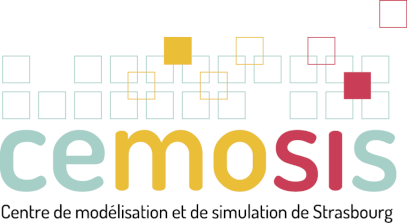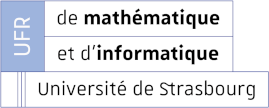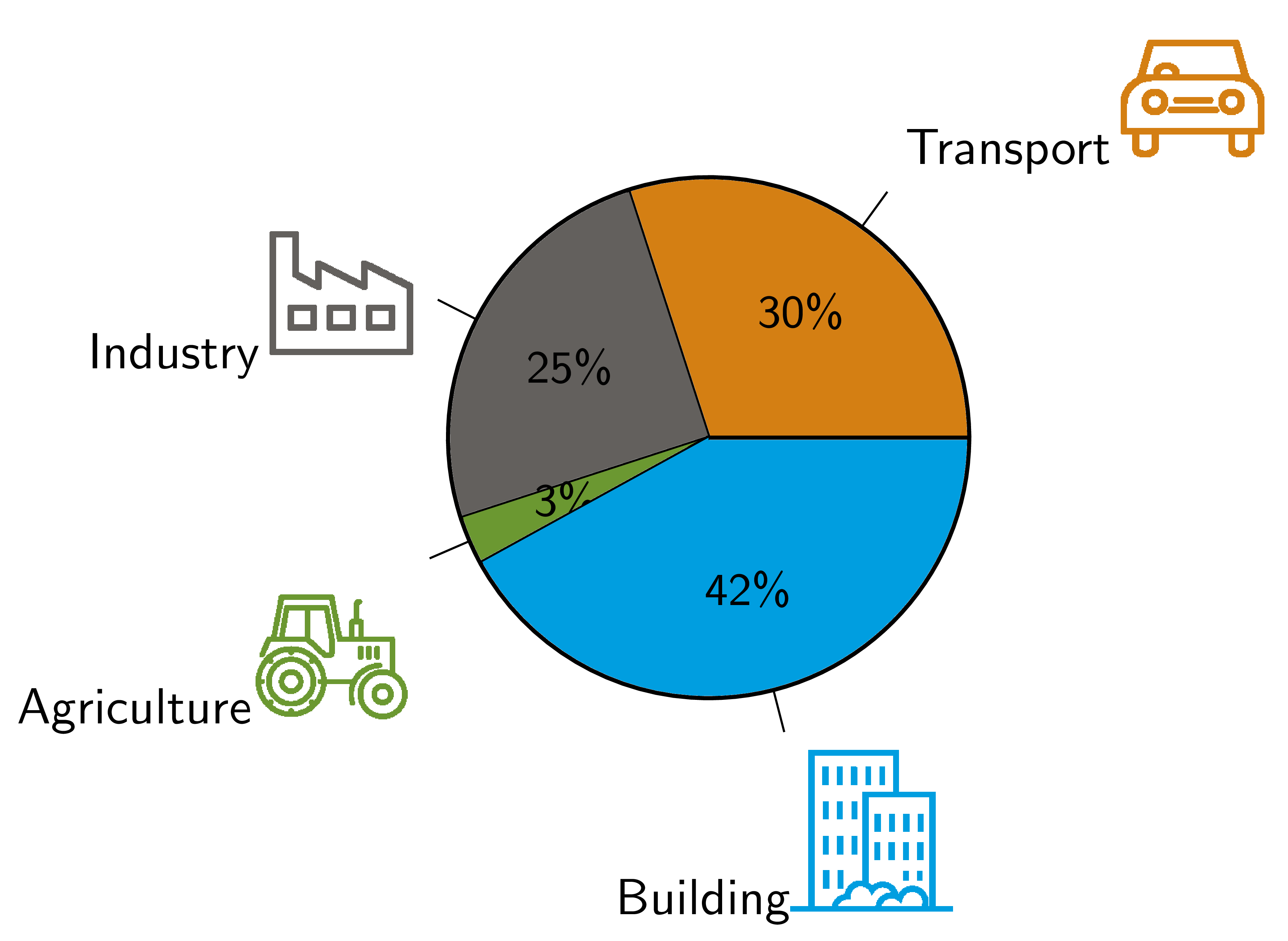Hygrothermal modeling and Simulation
First year internhip at the Centre de Modélisation et de simulation de Strasbourg

M1 CSMI

Supervized by
Vincent Chabannes, Zohra Djatouti, Romain Hild & Christophe Prud'homme
From June 8th 2020 to August 7th 2020
| This report is a summary of a master’s internship work. It is a follow-up of a semester project. The report is available here. A quick summary of this report can be found on this page. |
Introduction
1. Context
According to the Intergovernmental Panel on Climate Change, the global warming of the planet is due to part because of human activities, particularly the high energy consuming ones [source]. As shown in figure 1, in France, the building sector stands for the first responsable of the final energy consumption [source], befor industry and transport sectors.

To face the challange of mittigating the global warming of the planet, [Paris Agreement], approved by 196 contries and adopted by consensus in december 2015 have set as a main objective to hold the global warming lower than 2ºC above pre-industrial levels and purse the efforts to limit it to 1.5°C. To achieve this, many measures have been taken at different levels. For innstance, one of goals of the french gouvernment is reducing by half the final energy consumption of the country by 2050 [source]. This ambitious goal can only be achieved if considerable efforts are made to reduce the energy demande of industy, trnsport and above all, building sector. The energy consumption of buildings can be reduced by a designing more efficient new buildings and renovating the existing buildings.
In this context, engineers and researchers constantly work to improve and develop relevant tools and methods for the design optimization of building energy solutions.
Some corrections: The project 4fastsim-ibat, initiated at the Cemosis platform aims to develop a fast and efficient tool combining physical models, artificial intelligence, and in-situ measurements to identify potential energy-saving in existing buildings and to evaluate design and renovation solutions before their implementation. Many domains are involved in this project. For example, my colleagues Hanane and Sarra work on management of missing data in building thermics and Romain works on radiative heat transfert for their internships.
The objective of the present internship is to extend the work initiated during the semester project to a whole building hygrothermal problem.
During the second semester of the year, I worked on a project at Cemosis. This internship is its continuation. During this project, we studied the heat and moisture transport process and implemented an application allowing us to simulate this transport with Feel++. This application was designed to work on specific cases. The main objective of this internship is to improve this program, allowing the user to configure it for different cases, and also to use it on more complex geometries. Another objective is to introduce quantities eveluating the thermal comfort of occupants of a room and visualize them, to help in energy system management in conception and renovation of buildings.
2. Cemosis
The 4fastsim-ibat project is a collaboration between Cemosis and Synapse Concept.
Cemosis, is a technological platform in mathematics at the University of Strasbourg, which links mathematics with business and other disciplines. It was created in January 2013, it is hosted by the IRMA (Institut de Recherche de Mathématique avancée), and is based on the Modelling and Control team.
3. Synapse Concept
Synapse Concept is a company specialized in fluid and thermal simulation and virtual and augmented reality. It was creted in 1999 and has many competences.
4. Plan
The very beginning of the internship will consist in improving the unsatisfactory results obtained at the end of the project. Then we will study an other benchmark case, which involves only moisture transport process.
After that, we will improve the application feelpp_hm_heat_moisture whose development began during the semester project, by adding the possibility to configure the cases with JSON files. We will also add a feature that allows to calculate the heat and moisture transfer in a building, within the walls and the room.
Then, we will work on the implementation of a feature for thermal comfort assessment. Finally,, we will study another strategy to solve the equation, using the Hybrid Discontinue Galerkin method. For illustration, we will focus on the heat equation from the coupled wall-room model, in the case of Bestest.
5. Technical details
The codes of the application can be found on the GitHub repository.
The state of the applications at end of the internship is as follows:
-
The application
feelpp_hm_heat_moisturesimulating heat and moisture only in a porous wall did work. The code of this app is merged in themasterbranch and can be found at this state in history. The documentation of this application is on this page. -
The coupling between the room and the wall is not working yet (even if the code compiles). The code is in the branch
model, first used to develop the previous application. The name of this application isfelpp_hm_heat_moisture_2dorfeelpp_hm_heat_moisture_3d, depending in which dimension we are. At the end of the internship, the code was at this state in history. The documentation can be found here.
To build the application, go in the branch feature/quickstart of the repository feelpp (see the GitHub repository), then in the root of the cloned folder write :
cd feelpp/research && ln -s ../../hygrothermie
The folder feelpp and hygrothermie have to be in the same parent folder.
|
Then, in Visual Studio Code, build the target feelpp_hm_heat_moisture (or feelpp_hm_heat_moisture_[2d|3d] for the coupling application).
Once the target is built, go to the build folder and type
ninja hygrothermy_add_testcase_cases
to add the files used for the simulation (geo, JSON and cfg), present in the folder src/cases.
After my internship was finished, the files have been reorganized and the name of the application is now feelpp_ht_heat_moisture. See the GitHub repository for more details.
|
7. Acknowledgment
As this internship is the following of the project made during the completed semester, I would like to thank the team of Cemosis who hosted me for this two-months internship. Even if it was in teleworking and during the summer holidays, my tutors were available to answer my questions and guide me in the work.
Especially, I thank :
-
Zohra Djatouti for the physicals details she provided me to help me understanding the hygrothermal transport processes and the studied cases
-
Romain Hild for the technical details he provided me for the usage of Feel++ functions that were not easy to handle
-
Christophe Prud’homme for his disponibility to answer my questions (even on a highway !), and for the skeleton of code he made.
Even though some of the programs were not fully operational at the end of the internship and despite the fact that some notions and methods were not easy to apprehend, I found this internship very interesting and instructive.
8. Defense
The support of the presentation held on August 26th can be found here.